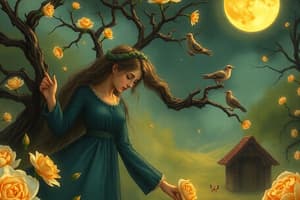Podcast
Questions and Answers
What is the primary action that the caterpillar is urged to do?
What is the primary action that the caterpillar is urged to do?
- Spin a web
- Fly away
- Take a walk (correct)
- Hide in a cocoon
What natural element is specifically mentioned as a potential danger to the caterpillar?
What natural element is specifically mentioned as a potential danger to the caterpillar?
- A spider
- A bird of prey (correct)
- A lizard
- A worm
What transformation is implied at the end of the poem?
What transformation is implied at the end of the poem?
- The caterpillar becoming a moth
- The caterpillar remaining the same
- The caterpillar turning into a dragonfly
- The caterpillar dying and being reborn as a butterfly (correct)
Which phrase indicates a sense of urgency in the caterpillar's actions?
Which phrase indicates a sense of urgency in the caterpillar's actions?
What does the poem suggest about the final state of the caterpillar?
What does the poem suggest about the final state of the caterpillar?
What is the primary representation of the caterpillar's journey in the poem?
What is the primary representation of the caterpillar's journey in the poem?
What is implied will happen to the caterpillar as it hides?
What is implied will happen to the caterpillar as it hides?
Which imagery is used to suggest potential threats to the caterpillar?
Which imagery is used to suggest potential threats to the caterpillar?
How does the poem describe the caterpillar's state before transformation?
How does the poem describe the caterpillar's state before transformation?
What can be inferred about the caterpillar's future from the poem?
What can be inferred about the caterpillar's future from the poem?
Flashcards are hidden until you start studying
Study Notes
Overview of "The Caterpillar"
- Written by Christina Rossetti, a prominent Victorian poet known for her themes of nature and transformation.
- The poem captures the lifecycle of a caterpillar, emphasizing its hurried existence and impending metamorphosis.
Imagery and Symbolism
- Brown and Furry: The caterpillar is described with tactile imagery, highlighting its appearance and creating a sense of familiarity.
- In a Hurry: Suggests urgency and perhaps the fleeting nature of life and growth.
- Shady Leaf or Stalk: Represents safety and a nurturing environment, essential for the caterpillar's development.
Themes
- Transformation: The poem centers on the theme of metamorphosis, a symbol of change and renewal.
- Life Cycle: Depicts the natural progression from caterpillar to butterfly, hinting at the notion of death and rebirth.
- Vulnerability: The caterpillar’s need to avoid predators conveys the fragility of life.
Structure and Tone
- Simple Rhyming Scheme: The poem employs a playful yet poignant rhyme, contributing to its lyrical quality.
- Tone of Anticipation: The ending evokes a sense of hope and rebirth, emphasizing positive transformation.
Conclusion
- The caterpillar's journey serves as a metaphor for personal growth and the inevitable cycles of life, resonating with themes of hope, change, and the beauty of nature.
Overview of "The Caterpillar"
- Written by Christina Rossetti, a prominent Victorian poet known for her themes of nature and transformation.
- The poem captures the lifecycle of a caterpillar, emphasizing its hurried existence and impending metamorphosis.
Imagery and Symbolism
- Brown and Furry: The caterpillar is described with tactile imagery, highlighting its appearance and creating a sense of familiarity.
- In a Hurry: Suggests urgency and perhaps the fleeting nature of life and growth.
- Shady Leaf or Stalk: Represents safety and a nurturing environment, essential for the caterpillar's development.
Themes
- Transformation: The poem centers on the theme of metamorphosis, a symbol of change and renewal.
- Life Cycle: Depicts the natural progression from caterpillar to butterfly, hinting at the notion of death and rebirth.
- Vulnerability: The caterpillar’s need to avoid predators conveys the fragility of life.
Structure and Tone
- Simple Rhyming Scheme: The poem employs a playful yet poignant rhyme, contributing to its lyrical quality.
- Tone of Anticipation: The ending evokes a sense of hope and rebirth, emphasizing positive transformation.
Conclusion
- The caterpillar's journey serves as a metaphor for personal growth and the inevitable cycles of life, resonating with themes of hope, change, and the beauty of nature.
Studying That Suits You
Use AI to generate personalized quizzes and flashcards to suit your learning preferences.




